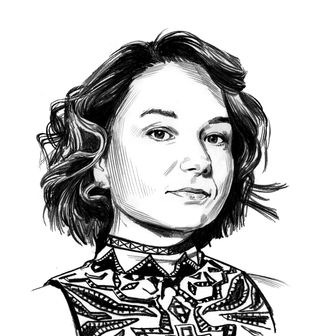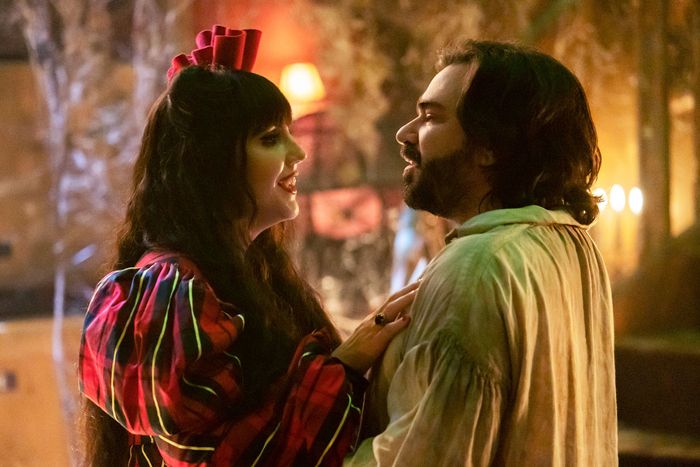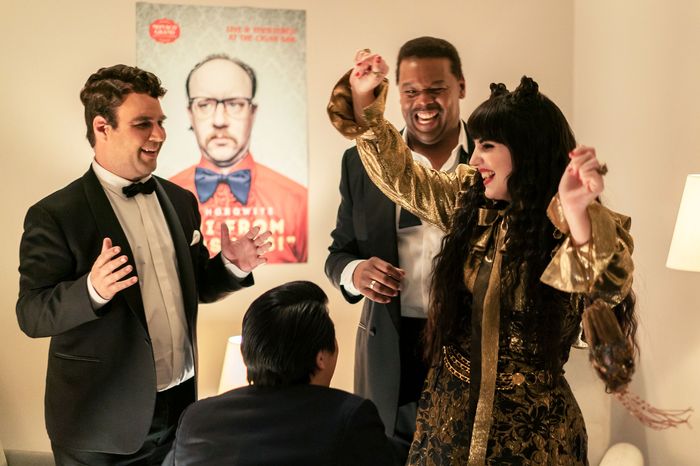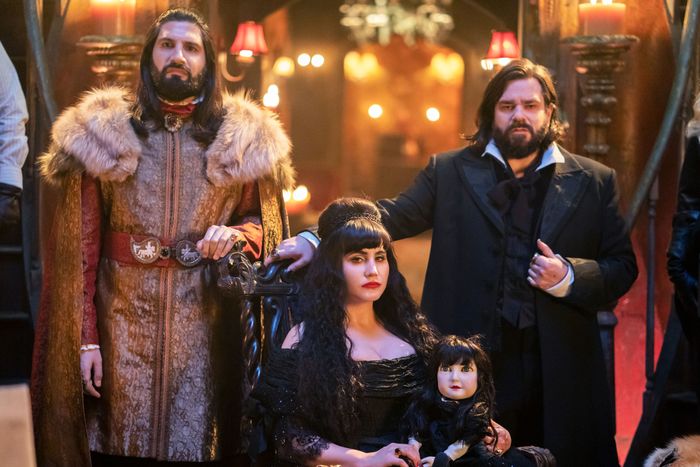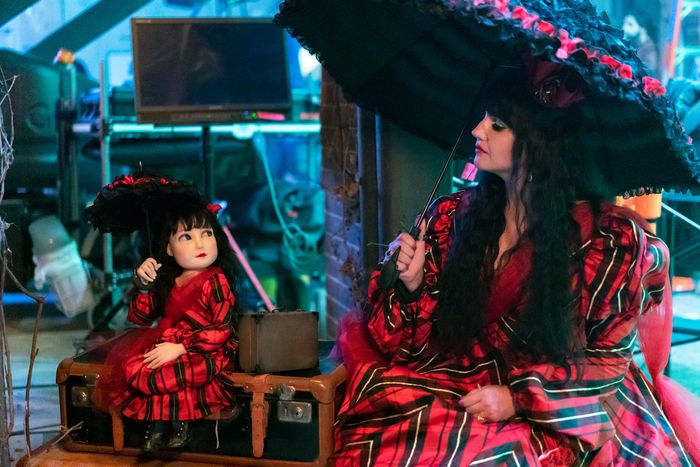
When Laura Montgomery joined What We Do in the Shadows as assistant costume designer in season one, the visual identity of the show’s sole leading lady was closely tied to her husband. “Jemaine [Clements]’s big thing with Laszlo and Nadja was that he always wanted them to match,” Montgomery told me in an interview over Zoom. Though vampire Nadja, played with a menacing goofiness by Stath Lets Flats star Natasia Demetriou, was born to a peasant family on the tiny island of Antipaxos, Greece some 500 years ago, Laszlo’s British Victorian origins influenced the pair’s early appearances in the FX mockumentary series: giant matching lace collars (which Montgomery still has and hopes to use again), jaunty black top hats, and garments sewn from the same gold brocade fabric. But when Montgomery stepped in as head costume designer in season three — and Nadja’s ambitions began diverging from her husband’s — “there was freedom to go bigger,” a shift which allowed Nadja’s clothes to highlight her singular personality.
In the season-four premiere, Demetriou makes an entrance in her most colorful ensemble yet: a very full, very bright-red plaid gown, a nod to the year Nadja just spent working for the Worldwide Supreme Vampiric Council in London. Because Montgomery needed enough fabric for two gowns (one would get wet during a fall into a flooded basement), and the vision she had was so specific, her team ended up creating their own plaid. Montgomery wanted a red and black pattern with a yellow stripe to evoke the work of late British designer Alexander McQueen, so her team sewed a yellow ribbon into red-and-black fabric they found in the correct proportions. The completed look includes a Vivienne Westwood-inspired V-neckline and a Kate Middleton–esque fascinator to convey the sense that Nadja’s arrived fresh from across the pond. The entire process took the costume team about two weeks.
The craftsmanship that goes into Nadja’s costumes is evident to even the casual viewer, but their effect on screen can take a moment to truly appreciate. As Demetriou stomps and struts and screams her way through the vampires’ dark, creaky house, her gowns, usually made in rich, dark velvets with dramatic shoulders, billowing sleeves, and a full skirt, emphasize her dominating presence. When she talks, the others listen; when she shouts, her roommates (usually) capitulate. Montgomery is conscious of not allowing any garment to swallow Demetriou’s performance, but season four’s experimentation delivers Nadja looks the likes of which we’ve never seen: the red nail-tipped gloves of a true drag queen, a whimsical pair of smaller top hats combined to make one big double top hat, and reading glasses that appear to have their own mini chandelier. “That’s the benefit of being a few seasons into it,” Montgomery said. “We have the confidence to put something on the screen that people want to look at.’”
Though Nadja’s style remains heavily influenced by the Victorian era (“Natasia herself loves the big shoulders and that mutton-leg sleeve,” Montgomery said), Shadows is not a period piece, so none of her gowns are constrained by historical accuracy. Modern elements like a Chanel belt that appeared in season-three episode “Atlantic City” often pop up, and Demetriou is free to skip the nasty business of wearing a corset for hours on end. “For some garments we might build in some structure so it doesn’t collapse on itself,” Montgomery tells me. “But the rest, that’s just her body.” This flexibility allows Montgomery to accommodate the physical demands of the show, which requires its actors to fly around in harnesses, fall into bodies of water, projectile vomit and ransack a neighboring house in search of lost property. Then there are the talking-head interviews, usually filmed with the actors seated, which present their own set of challenges. “Usually we do our fitting standing, so I’ll take the picture and it looks great.” Montgomery said. “Then she gets to set and the bodice rides up to her chin if she sits.”
Because Nadja exists in a contemporary timeline and can wear what she wants, Montgomery is free to create a shape that emphasizes Demetriou’s assets as opposed to constricting her. In a sense, her gowns reshape a uniform of patriarchal conformity — Victorian corsetry famously endangered its wearers internal organs, and many gowns of the era sent their wearers to fiery deaths — into a demonic power fantasy. They allow Nadja to make the decision to take up more space while remaining perfectly feminine, in what feels like a giant middle finger to our cultural tendency to present femininity hand in hand with smallness.
Demetriou’s actual body is rarely on display; she is virtually enveloped in fabric — practically a suit of armor — but at the same time, nothing about her costumes feel modest, and her character certainly never shies away from her sexuality. One exception is her look in the season-three finale “The Portrait,” where her boat neck gown reveals actual cleavage. “I would never want to make someone look like an object or really sexualized, but she’s so beautiful and she’s the only woman [in the main cast],” Montgomery adds. “It’s not being afraid to show her skin, to show femininity.” If anything, the gown served to highlight the emotional vulnerability Nadja finally laid bare in a very powerful episode. To accomplish that without objectification, or a sense of shrinking or weakness, feels truly radical.
Femininity and aggression are elements that a heteronormative, patriarchal mindset keeps at odds, and so Demetriou screaming at someone while laced into a bustled gown summons an energy rarely seen outside of drag shows. In season two, when Nadja discovers that her vampire housemate Nandor was the warlord who raided her village hundreds of years ago, she flies into a murderous frenzy. “I swear, I am going to rip that man to shreds and make a dress out of it,” she roars, “and go to his family’s house and say ‘Do you like this? This is your son and I’m wearing him as a dress.’” After centuries of women maiming and killing themselves to reach a feminine ideal, Nadja feels like revenge — a demon disguised in the trappings of hundreds of years of oppression, existing solely to maim, kill, and make scumbag frat boys eat bricks.


